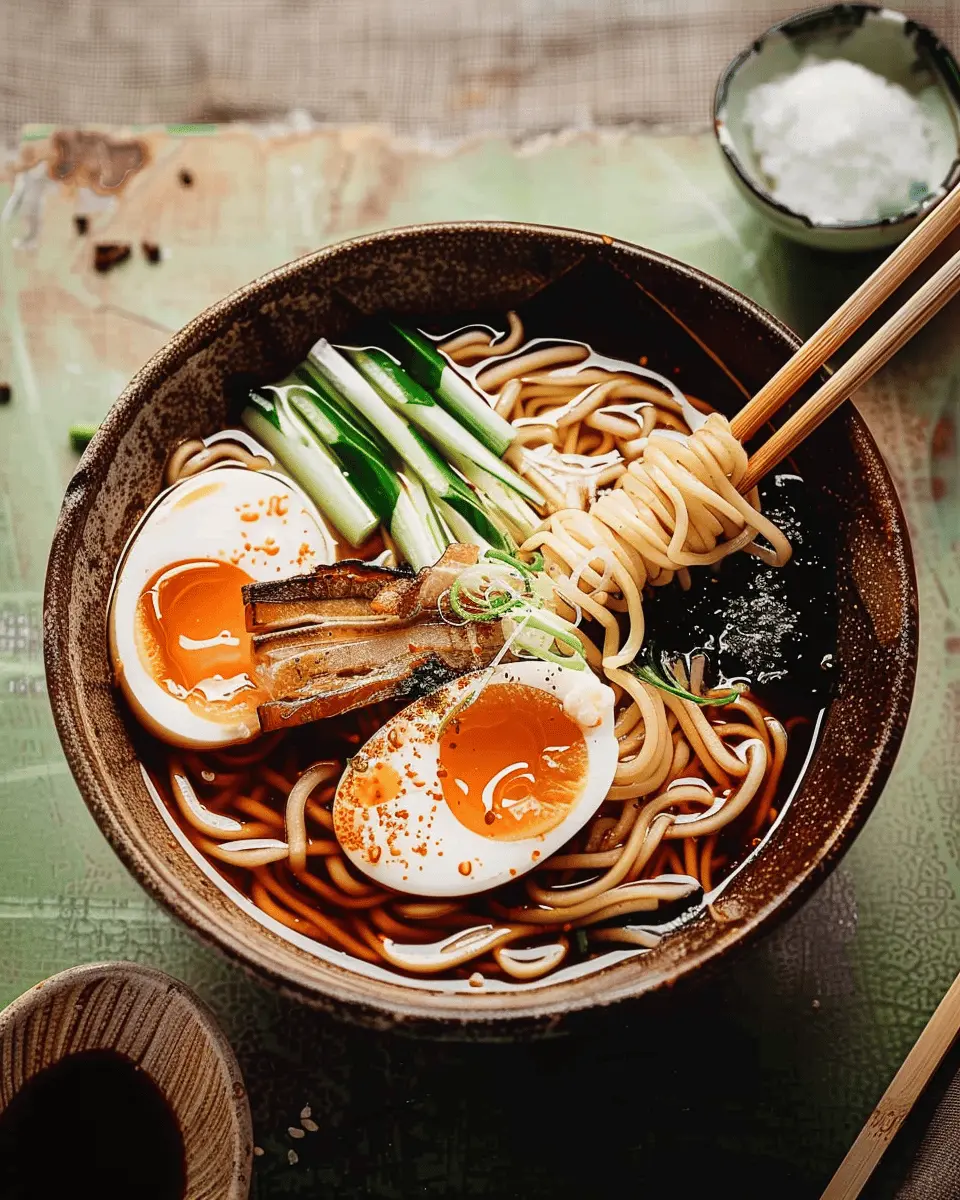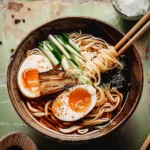Introduction to Shoyu Ramen Noodles
When it comes to comfort food, shoyu ramen noodles stand out as a delicious choice that infuses warmth and happiness into your cooking routine. If you’re a fan of hearty broths, savory toppings, and slurp-worthy noodles, then you’ll definitely want to dive into the world of shoyu ramen. This beloved Japanese dish, known for its rich soy sauce base, is not just a meal; it’s an experience waiting to unfold right in your kitchen.
Why Shoyu Ramen is a Must-Try for Homemade Food Lovers
First, let’s talk about the luscious flavors involved. Shoyu, which translates to soy sauce, provides a deep, umami taste that awakens your taste buds. Unlike other ramen styles, Turkish noodles are more than just a vessel for broth; they are crafted with care, often incorporating unique ingredients like turkey bacon or chicken ham to enhance the overall dish. For anyone eager to experiment with flavors, these noodles are a canvas for creativity.
But the joy doesn’t stop there! Preparing homemade shoyu ramen noodles also offers you the flexibility to cater to your dietary preferences. With just a few substitutions, such as opting for vegetable broth or gluten-free noodles, you can make this dish truly your own. Plus, the act of simmering the broth and cooking the noodles can be a meditative experience, perfect for winding down after a long day.
What makes shoyu ramen truly special is its rich history and cultural significance. Originating in Japan, this dish has evolved and adapted over time, reflecting regional variations and personal twists. For more insights on ramen’s journey, you might find articles from The Ramen Rater or Serious Eats enlightening.
Finally, let’s not ignore the community aspect of ramen-making. Inviting friends over for a ramen night can be a creative bonding experience. Who can resist the charm of customizing toppings—whether it’s crispy turkey bacon, fresh scallions, or soft-boiled eggs? It’s a social event as much as it is a flavorful feast.
In summary, incorporating shoyu ramen noodles into your culinary repertoire not only delivers satisfaction through taste but also offers the chance to explore, create, and share. So grab your ingredients and get ready for a rewarding cooking adventure!
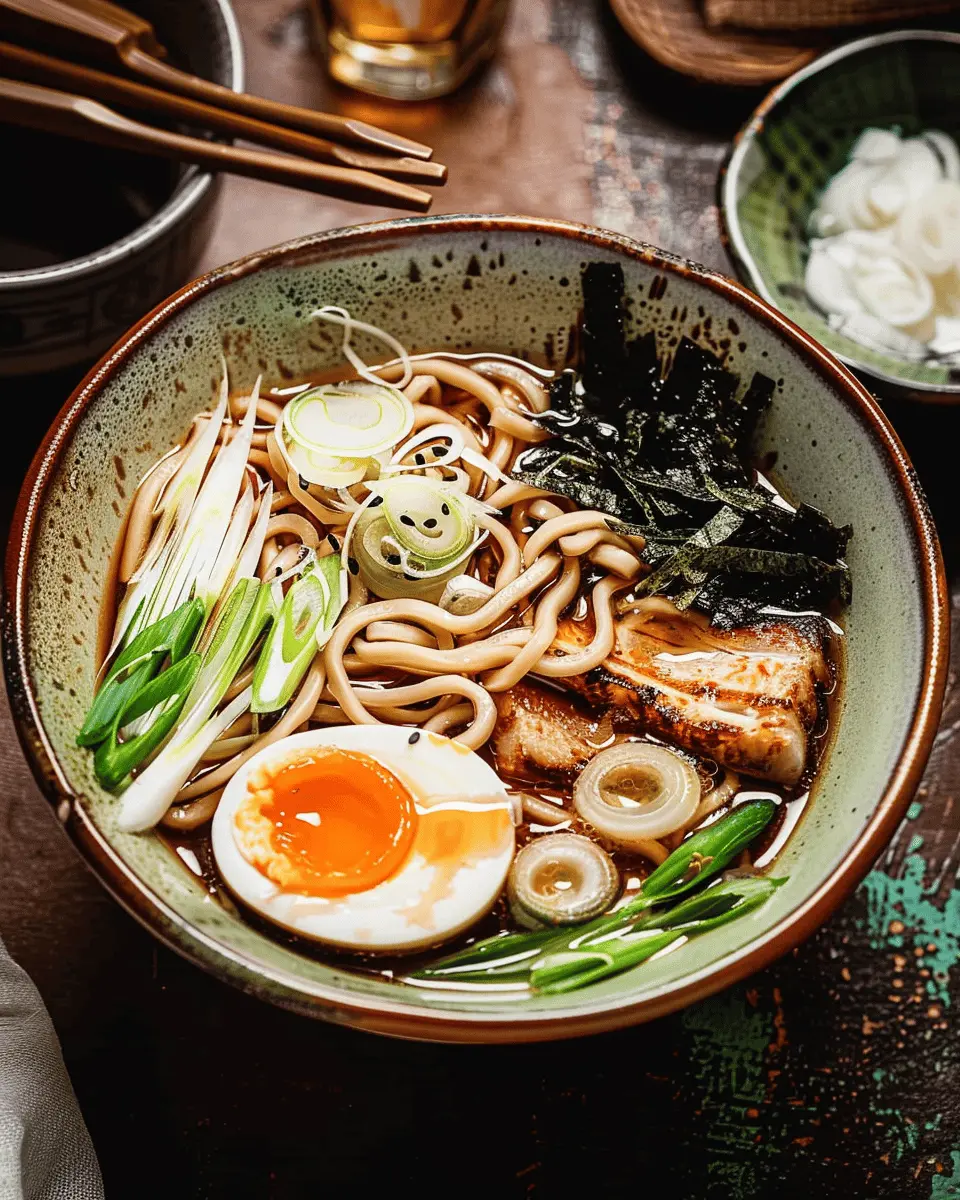
Ingredients for Shoyu Ramen Noodles
Essential ingredients for the perfect shoyu ramen
To whip up a delightful bowl of shoyu ramen noodles, be sure to gather these essential ingredients:
- Noodles: Fresh ramen, if available, or dried noodles that cook easily.
- Broth: A rich chicken or beef broth, homemade is best for depth of flavor!
- Soy Sauce: The star of shoyu ramen, giving that umami punch.
- Mirin or Rice Vinegar: For a touch of sweetness and balance.
- Ginger and Garlic: Freshly minced for that aromatic kick.
- Scallions: Sliced thinly to enhance both flavor and presentation.
Optional toppings and add-ins for customization
Feel free to personalize your shoyu ramen noodles experience! Consider adding these delightful toppings to make your dish truly yours:
- Egg: Soft-boiled for a creamy texture.
- Turkey Bacon: A lighter, yet flavorful option.
- Chicken Ham: Adds a savory note that complements the broth.
- Mushrooms: Shiitake or enoki add a lovely earthiness.
- Greens: Spinach or bok choy for a nutritious crunch.
- Nori: Seaweed sheets for an authentic touch.
These ingredients will help create a bowl of ramen that’s not just a meal, but an experience. For more tips on creating delicious ramen, check out Serious Eats for an in-depth look at broth-making techniques!
Step-by-Step Preparation of Shoyu Ramen Noodles
Making shoyu ramen noodles can seem overwhelming, but with a bit of preparation and guidance, you’ll find it’s quite the gratifying process. Ready to dive into this delectable culinary adventure? Let’s break it down step-by-step!
Preparing the Broth
The heart and soul of any ramen is its broth. For shoyu ramen, a soy sauce base is key, giving it that distinct umami flavor.
-
Gather your ingredients: You’ll need beef bones, water (about 6 cups), garlic, ginger, scallions, and, of course, soy sauce. A dash of kombu (dried seaweed) can add even more depth to your broth.
-
Bring your water to a boil: Start by placing your beef bones in a large pot and covering them with water. Bring it to a rapid boil and then lower the heat.
-
Simmer and infuse: Add crushed garlic, sliced ginger, and chopped scallions. Let the broth simmer for at least 3-4 hours. The longer you simmer, the richer the flavor.
-
Season to taste: When your broth is ready, strain the solids out and stir in a generous splash of soy sauce. Taste it! You might find it needs a little more salt or an extra hint of umami. Perfecting your broth is a balance; trust your taste buds!
Start with a potential broth recipe like the one from Serious Eats to guide you!
Cooking the Noodles
Next up, the noodles! Whether you choose fresh or dried, mastering them is vital for great shoyu ramen noodles.
-
Choose your noodles: Fresh ramen noodles are fantastic, but dried noodles work in a pinch. If using fresh, you may not need to boil as long. Typically, cooking them for about 4-5 minutes is perfect.
-
Water at a boil: Bring a pot of salted water to a rolling boil. This helps season the noodles just as they cook.
-
Cook and rinse: Add the noodles to the boiling water. Once they’re al dente, drain and rinse them under cold water to stop the cooking process. This also helps keep them chewy!
Preparing the Protein
Now, about that protein! Depending on your personal preference, you can either use turkey bacon or chicken ham.
-
Cook the turkey bacon: In a non-stick skillet, fry the turkey bacon until it’s crispy and golden brown. Flip it often for even cooking.
-
Chicken ham preparation: If you go with chicken ham, simply slice it thinly and sauté it lightly to warm it through.
-
Flavor the protein: Both turkey bacon and chicken ham can be seasoned with a sprinkle of soy sauce or even a bit of black pepper to enhance their flavors.
Assembling the Ramen Bowl
With all your components ready, it’s time for the fun part—assembling the bowl!
-
Noodle first: Start with a base of beautifully cooked noodles in a large bowl.
-
Ladle the broth: Pour your aromatic broth over the noodles, allowing it to coat them evenly.
-
Add your protein: Lay your crispy turkey bacon or sautéed chicken ham atop the noodles.
Adding Garnishes and Finishing Touches
The last step is about personalization and presentation.
-
Classic toppings: Consider adding soft-boiled eggs, nori (seaweed), and sliced green onions.
-
Extra flavor: A sprinkle of sesame seeds or a drizzle of chili oil can add a nice kick.
-
Final aesthetic: Make your ramen visually pleasing; arrange toppings beautifully, and don’t forget a dash of fresh herbs, like cilantro or basil, for that gourmet touch.
Enjoy your homemade shoyu ramen noodles! This luscious dish not only warms the belly but also the soul. So, grab your chopsticks and dig in!
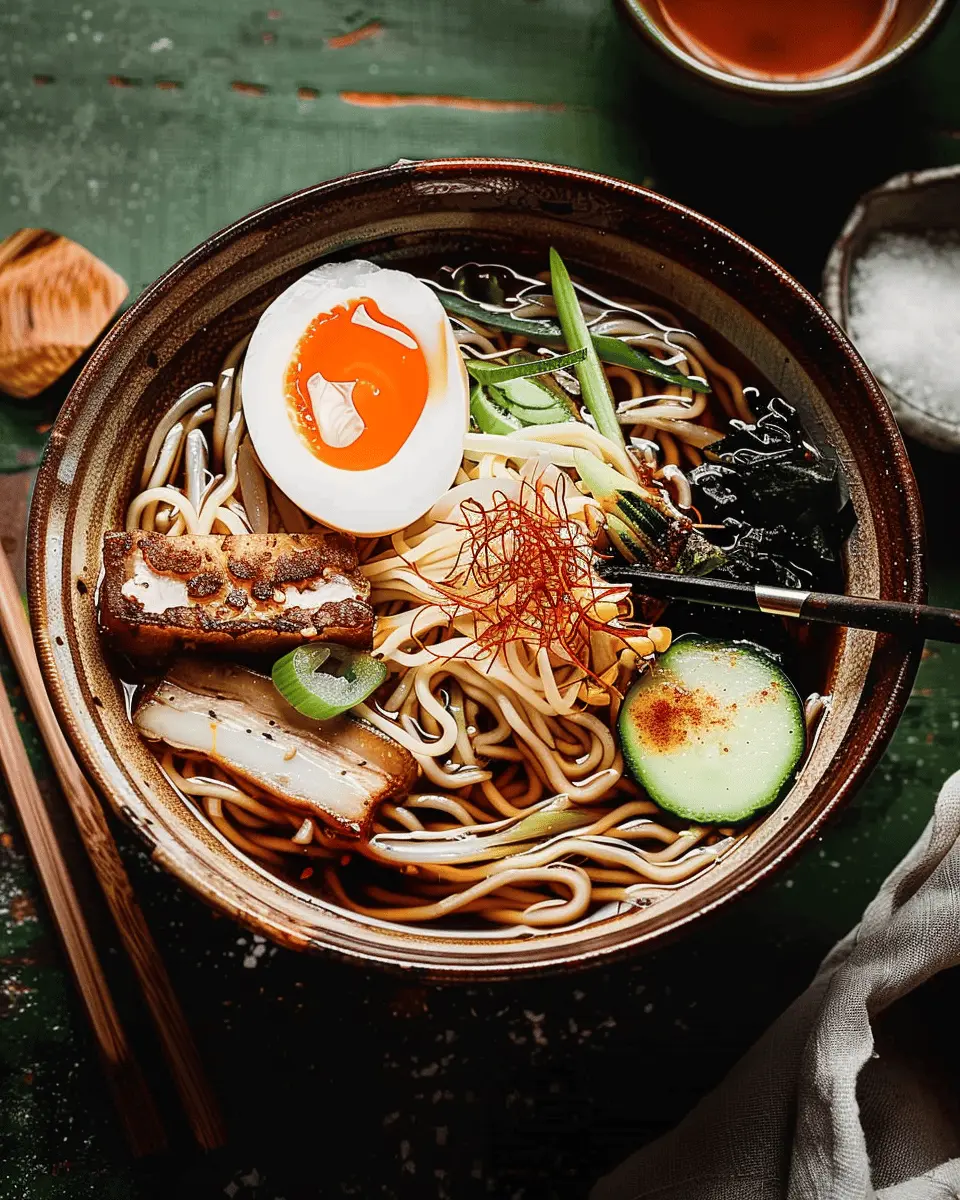
Variations of Shoyu Ramen Noodles
Exploring the versatility of shoyu ramen noodles can lead you down delicious paths you may never have considered. Whether you’re a vegetarian, a spice enthusiast, or someone who loves to experiment with fusion cuisine, there’s a perfect bowl waiting for you.
Vegetarian Shoyu Ramen
For those seeking a meatless option, vegetarian shoyu ramen noodles are incredibly satisfying. Start by replacing traditional broth with a rich vegetable stock. Adding mushrooms enhances umami, while leafy greens like bok choy provide freshness. Top with tofu for protein and don’t forget the essential garnishes—green onions, nori, and sesame seeds. Check out this great vegetable stock recipe here to get started.
Spicy Shoyu Ramen
If you crave heat, spicy shoyu ramen noodles will tickle your taste buds. Incorporate a dash of chili oil or a spicy miso paste to your broth for that fiery kick. Add sliced turkey bacon or chicken ham for flavor, and consider topping your bowl with a spicy marinated soft-boiled egg. Delve deeper into the world of spicy ramen with insights from food experts who share their favorite additions.
Fusion Variations
Feeling adventurous? Why not take shoyu ramen noodles into uncharted territory? Picture a ramen burrito filled with savory broth-soaked noodles, grilled chicken, and fresh veggies wrapped snugly in a warm tortilla. Alternatively, shoyu ramen tacos could feature your favorite toppings in crunchy taco shells, providing the perfect vessel for the flavorful noodles.
Don’t hesitate to play with flavors and ingredients; there’s no wrong way to enjoy your ramen! Embrace creativity while crafting your culinary masterpiece.
Cooking Tips and Notes for Shoyu Ramen Noodles
Key secrets for a rich broth
To achieve a deep, umami flavor in your broth, start with high-quality beef bones or even a mixture that includes chicken bones for extra richness. Consider adding dried shiitake mushrooms or kombu (dried sea kelp) for an extra layer of depth. Slow simmering is key; aim for at least 6-8 hours to extract all those savory goodness. If you have time, making your own broth from scratch can elevate your shoyu ramen noodles to gourmet status. For guidance, check out this great resource on broth-making techniques.
Noodle cooking tips to avoid mushiness
To ensure your shoyu ramen noodles maintain that perfect texture, it’s crucial to cook them separately in boiling water. Follow the package instructions carefully, usually around 3-4 minutes for the best texture. Remember to taste them a minute or so before the timer goes off. You want them to be al dente since they’ll continue cooking when you add them to the hot broth. Rinse them under cold water afterward to stop the cooking process.
With these tips, you’re set to create an incredible bowl of ramen! Enjoy the process and feel free to experiment with toppings and seasonings that reflect your personal taste.
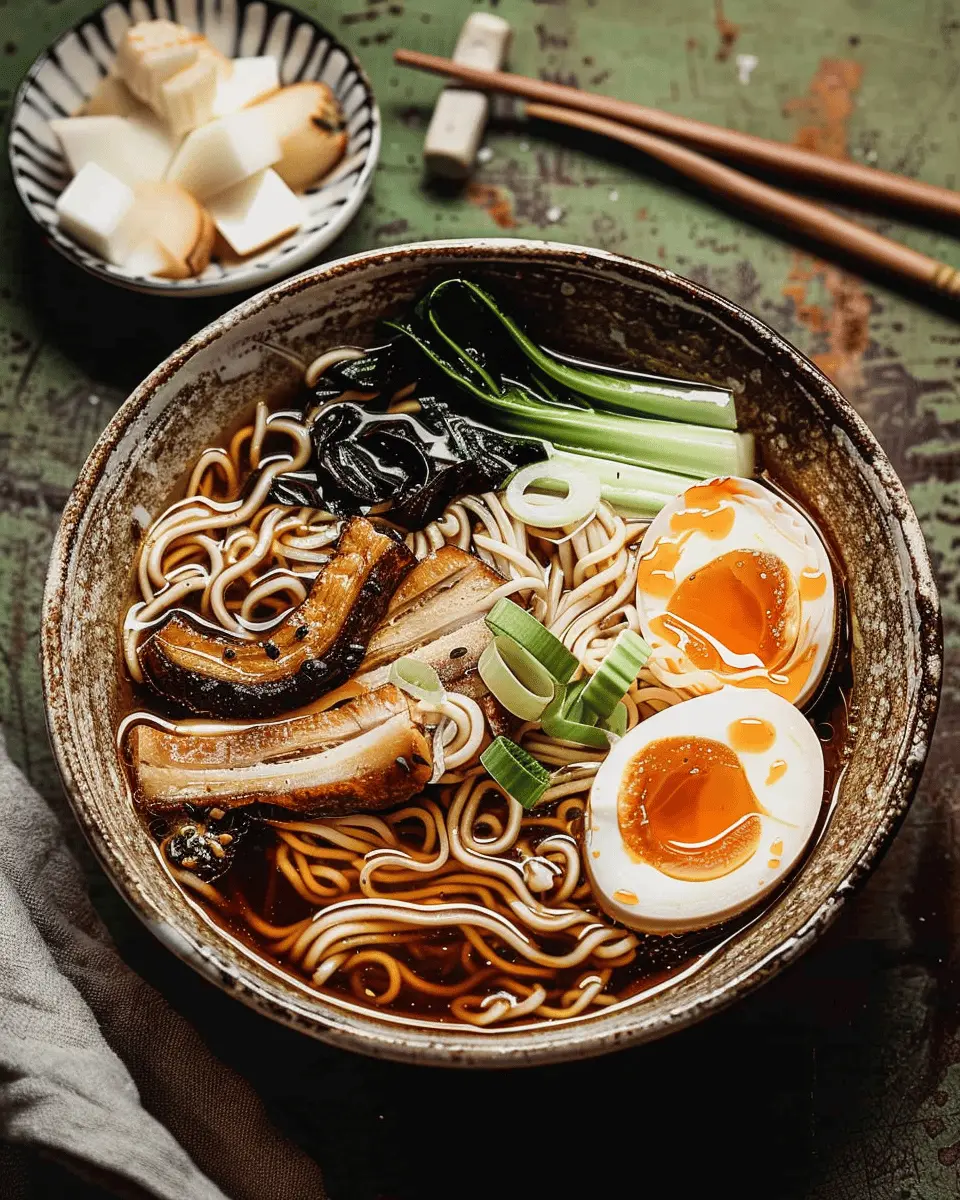
Serving Suggestions for Shoyu Ramen Noodles
Ideal accompaniments to enhance your meal
To truly elevate your shoyu ramen noodles, think about what flavors will complement that rich broth. Here are a few suggestions:
- Fresh Vegetables: Add some sautéed bok choy or steamed spinach for a nutritious crunch.
- Protein: Consider topping with sliced turkey bacon or chicken ham for a heartier meal. Even marinated tofu would be a great plant-based option!
- Herbs and Spices: A sprinkle of green onions or fresh cilantro can provide a burst of freshness, while a dash of chili oil adds a nice kick.
For more tips on how to incorporate vegetables into your ramen, check out this resource.
Creative serving styles that impress guests
Impress your dinner guests by serving your shoyu ramen noodles in unique ways.
- Bento Box Style: Arrange your noodles and toppings in a bento box. This not only looks stunning but also gives everyone a chance to customize their meal.
- Ramen Bar: Set up a DIY ramen bar with an array of toppings — think corn, seaweed, and soft-boiled eggs. Let guests build their perfect bowl, sparking fun conversation.
Playing with presentation turns a simple meal into a memorable experience! How do you like to serve your ramen?
Time Breakdown for Shoyu Ramen
Preparation Time
Getting your ingredients ready for shoyu ramen noodles is half the fun! You’ll need about 20 minutes for this. It’s a great chance to cut veggies or prep your proteins, like turkey bacon or chicken ham.
Cooking Time
Once your prep is done, cooking time rings in at approximately 25–30 minutes. This is where the magic happens—simmering the broth, cooking the noodles, and assembling everything.
Total Time
In total, you’re looking at around 50–60 minutes from start to finish. That’s a small investment for a huge reward—a delicious bowl of homemade shoyu ramen. If you want to dive deeper into ramen history or variations, consider checking out resources like Serious Eats for more insights!
Nutritional Facts of Shoyu Ramen Noodles
When it comes to satisfying your cravings with a bowl of shoyu ramen noodles, knowing the nutritional profile can help you enjoy this delicacy guilt-free. Here’s a quick breakdown of what you’re getting in a standard serving of shoyu ramen noodles:
Calories
A typical serving of shoyu ramen noodles contains around 380-400 calories. This makes it a hearty choice for a meal, perfect for refueling after a long day.
Protein
You’ll find approximately 12-15 grams of protein in these noodles, thanks to the inclusion of soy sauce and potential toppings like chicken ham or turkey bacon. Protein helps in muscle repair and keeps you feeling full longer.
Sodium
One area to watch out for is the sodium content, which can reach about 800-900 mg per serving. Higher sodium levels are typical in ramen dishes, so consider balancing your meal with fresh vegetables and low-sodium options when possible. For more insights on sodium intake, you can check guidelines from the American Heart Association.
Why not savor each slurp of shoyu ramen noodles while being mindful of these nutritional aspects? Enjoy your bowl, and feel good about your choices!
FAQs about Shoyu Ramen Noodles
Can I use instant noodles for shoyu ramen?
Absolutely, you can use instant noodles for shoyu ramen! They’re a convenient option if you’re short on time. While the texture might not match authentic ramen, a dash of soy sauce in the broth can elevate them. Just remember, authentic shoyu ramen noodles usually have that perfect chew—something instant noodles may lack. Feel free to experiment with flavors; consider upgrading your instant meal with a hard-boiled egg or some fresh green onions.
How do I store leftover ramen?
Storing leftover shoyu ramen noodles is straightforward. Separate your noodles from the broth to keep them from getting mushy. Here’s how to do it:
- Noodles: Place them in an airtight container and refrigerate them for up to 3 days.
- Broth: Store the broth separately in a sealed container. This keeps the flavor intact and prevents sogginess.
When you’re ready to enjoy your leftovers, reheat the broth and add the noodles just before serving. Toss in some fresh toppings to bring your dish back to life!
What are some non-traditional toppings for shoyu ramen?
While traditional toppings like pork chashu and green onions are fantastic, don’t hesitate to get creative! Here are some non-traditional toppings to consider:
- Turkey Bacon: Crispy turkey bacon adds a delightful crunch.
- Chicken Ham: Offers a unique flavor twist that complements the broth.
- Avocado: Creamy and rich, it pairs surprisingly well with ramen.
- Soft-boiled eggs: Elevate your dish with a perfectly runny yolk.
Feel free to explore additional toppings, as ramen is all about personalization. It’s your bowl, so make it your own!
For more inspiration, check out this article on unique ramen toppings.
Conclusion on Shoyu Ramen Noodles
Why making shoyu ramen at home is worth it
There’s something truly satisfying about crafting your own shoyu ramen noodles. The process allows you to control every ingredient and tailor flavors to your liking, resulting in a bowl that speaks to your taste buds.
Not only do homemade noodles infuse your dish with a personal touch, but you also save money compared to dining out. Plus, exploring the art of ramen-making can be a fun way to bond with friends or family.
For further inspiration and techniques, check out sources like Serious Eats or The Kitchn. Dive into the experience, enjoy every slurp, and before you know it, you’ll be in love with your homemade shoyu ramen!
PrintShoyu Ramen Noodles: Easy Homemade Delight with Turkey Bacon
A delicious and easy recipe for Shoyu Ramen Noodles made with turkey bacon.
- Prep Time: 10 minutes
- Cook Time: 15 minutes
- Total Time: 25 minutes
- Yield: 2 servings 1x
- Category: Lunch
- Method: Stovetop
- Cuisine: Japanese
- Diet: Low-carb
Ingredients
- 4 cups chicken broth
- 2 tablespoons soy sauce
- 1 tablespoon miso paste
- 1 block of ramen noodles
- 4 strips turkey bacon
- 1 boiled egg
- 2 green onions, sliced
- 1 sheet of nori, cut into strips
Instructions
- In a pot, bring the chicken broth to a simmer.
- Add the soy sauce and miso paste, stirring to combine.
- Cook the ramen noodles according to package instructions, then drain.
- In a skillet, cook the turkey bacon until crispy, then slice.
- Assemble the ramen by adding noodles to bowls, pouring broth over them, and topping with turkey bacon, boiled egg, green onions, and nori.
Notes
- For a vegetarian version, omit the turkey bacon.
Nutrition
- Serving Size: 1 bowl
- Calories: 450
- Sugar: 2g
- Sodium: 1200mg
- Fat: 20g
- Saturated Fat: 5g
- Unsaturated Fat: 10g
- Trans Fat: 0g
- Carbohydrates: 45g
- Fiber: 2g
- Protein: 25g
- Cholesterol: 150mg
Keywords: Shoyu Ramen, Homemade Ramen, Turkey Bacon Ramen

